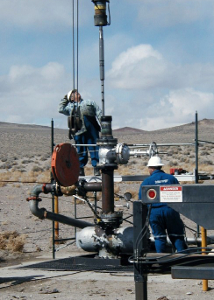Fracking and hot rock geothermal technologies both endure skepticism. The former will never win over a public (that readily enjoys the fruits of completed wells), at least not until oil and gas companies show more transparency. (See my earlier interview with author Peter Annin for more on that.) The latter could make a case to the public, but needs to take head-on concerns about earthquakes.
Today, I want to talk about the intersection of these two technologies: using fracking to increase production of deep, hot rock geothermal wells.

|
| Drillers conduct well logs at the Desert Peak site near Reno, Nev. Source: Department of Energy Geothermal Technologies Office |
A story in the Scientific American grabbed my attention this week. The article discusses the first “enhanced geothermal system” to latch onto the national power grid here in the United States. It’s called Desert Peak 2, and it’s run by Ormat Technologies near Reno, Nev. The “enhanced” in EGS refers to the use of fracking to boost the energy production of a standard hot rock well. Similar to gas production in shale, fluid is piped down the well to open fissures in the rock. In this case, fracking can apparently increase heat yield in areas with viable production and create yield elsewhere. Here’s a good primer from the Department of Energy.
David Danielson, assistant secretary for Energy Efficiency and Renewable Energy, called the project “a critical investment to ensure America leads in this growing global industry, helping to create new manufacturing, construction and operation jobs across the country while diversifying our energy portfolio and reducing pollution.”
He’s right.
The footprint of a geothermal well is relatively small and it typically operates at a greater depth than shale gas wells. Both those facts should help allay groundwater concerns. But not quite.
Oregon Public Broadcasting explores the issue in this story from 2012. The report talks about an EGS project near Bend, Ore., and some public controversy there. As you might expect, when you pair fracking and geothermal, critics will pair the drawbacks of both in opposing your project: the “secret sauce” of fracturing fluids and potential earthquakes.
(Why is it that every source of energy comes with an asterisk? That’s another blog post.)
Here’s my take: I like modern life. I offload a lot of my brain to my smartphone and perish the thought of giving it up. Yet, it needs charging every day. And that means energy. Americans, in particular, can have knee-jerk reactions to any kind of energy project. But I’m a practical guy. It makes sense, if we want energy, to reduce the impact of getting that juice.
I’m not a geologist, just a guy with opinions. But it seems that fracking at 10,000 feet has safety advantages over the much shallower work in shale, at least if your concern is groundwater. Still, thousands of feet of impermeable rock between a geothermal bed and my groundwater could help me sleep. As far as earthquakes, most of the seismic activity associated with this project is barely perceptible to people on the surface: all recorded events in the last year are under 1.5 magnitude, according to this site.
Atlas Copco engineers and others are working on down-hole hammers that can function more effectively in the high temperatures of extreme depths. This Massachusetts Institute of Technology report calls for a “new generation” of down-hole tools that can take the heat and “be useful for monitoring over the lifetime of the reservoir.” With hammers in testing, better monitoring equipment can’t be far behind to help deepen our understanding of how geothermal wells of this type trigger microquakes. With that knowledge, we can adjust the technology to minimize seismic activity.
There’s never going to be a perfect technology for harvesting energy. Our best bet is to weigh the pros and cons, and choose wisely. EGS makes sense to me and this project is well worth the $5.4 million Energy Department investment to make it happen.
Stay safe out there, drillers.


Report Abusive Comment